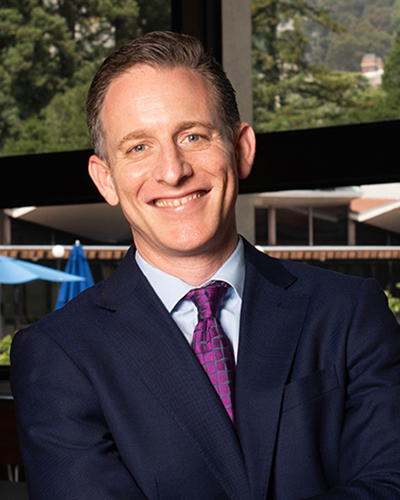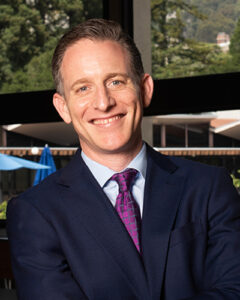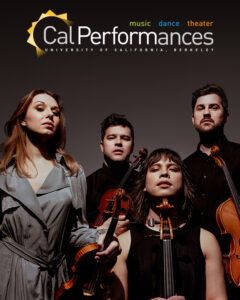Attacca Quartet
Sunday, February 4, 2024, 3pm
Hertz Hall
Cal Performances is committed to fostering a welcoming, inclusive, and safe environment for all—one that honors our venues as places of respite, openness, and respect.
Please see the Community Agreements section on our Policies webpage for more information.
From the Executive and Artistic Director

I’m so pleased to welcome you back to campus as we move into the second half of our extraordinary 2023–24 season. There are far too many highlights this month for me to mention each and every one, but I can’t help but single out a few standout events. Of course, any visit by the legendary soprano Renée Fleming is worthy of attention, and this month’s Zellerbach Hall appearance is no exception, coming, as it does, hot on the heels of her receiving the prestigious Kennedy Center Honor for lifetime artistic achievement in December. For dance, you won’t want to miss a dazzling double-bill pairing the late Pina Bausch’s iconic The Rite of Spring with common ground[s], a new duet co-created and performed by septuagenarians Germaine Acogny, known as the “mother of African contemporary dance,” and Malou Airaudo, a longtime dancer with the Tanztheater Wuppertal Pina Bausch. Featuring more than 30 dancers from 14 African countries assembled through a collaboration with Germany’s Pina Bausch Foundation, Senegal’s École des Sables, and the UK’s Sadler’s Wells theater, this program is the type of large-scale and ambitious artistic collaboration that has long defined Cal Performances. And finally, we’re tremendously excited about Taylor Mac & Matt Ray’s upcoming Bark of Millions (see page 6 for more details), an epic “parade trance extravaganza” that celebrates queerness in all its facets and the power of individuality and human connection to push boundaries and bring bold and fresh perspectives to our stage.
As spring approaches, we will continue to invest in ongoing relationships with established and acclaimed artistic partners, with upcoming projects including the renewal of a multi-season residency by The Joffrey Ballet, which this year will present its first full-length narrative ballet, Anna Karenina, at Zellerbach Hall. And I’m especially pleased that in March, the renowned pianist Mitsuko Uchida will join us as Artist in Residence for two special concerts as well as additional opportunities for the campus and wider Bay Area community to engage with her singular artistry.
An ongoing focus of the season is our multi-dimensional Illuminations programming, which once again connects the work of world-class artists to the intellectual life and scholarship at UC Berkeley via performances and public programs investigating a pressing theme—this season, “Individual & Community.” Concepts of “individual” and “community” have been at the forefront of public discourse in recent years, with new questions emerging as to how we can best nurture a sense of community and how the groups we associate with impact our own sense of self. Given our fast-evolving social landscape, how can we retain and celebrate the traits that make each of us unique, while still thriving in a world that demands cooperation and collaboration? With the performing arts serving as our guide and compass, we will explore the tensions that come into play when balancing the interests of the individual with those of the group.
Finally, I want to mention a major new venture coming up next season, the Maria Manetti Shrem and Elizabeth Segerstrom California Orchestra Residency, when Cal Performances and the Philharmonic Society of Orange County will bring the world renowned Vienna Philharmonic and conductor Yannick Nézet-Séguin to California during spring 2025. Made possible by philanthropists Maria Manetti Shrem and Elizabeth Segerstrom, three performances at Zellerbach Hall (March 5–7) will be followed by two in Orange County (March 9 and 11) at the Renée and Henry Segerstrom Concert Hall. Programs will feature works by Mozart, Schubert, Dvořák, Mahler, and Richard Strauss, with acclaimed pianist Yefim Bronfman set to join the orchestra for a Beethoven concerto appearance. Exact programming will be announced shortly, and on-sale dates will be provided in April, when Cal Performances’ 2024–25 season is announced to the general public.
Again, welcome to Cal Performances! We’re delighted to join together, celebrating the very best in live music, dance, and theater.
Jeremy Geffen
Executive and Artistic Director, Cal Performances
 I’m so pleased to welcome you back to campus as we move into the second half of our extraordinary 2023–24 season. There are far too many highlights this month for me to mention each and every one, but I can’t help but single out a few standout events. Of course, any visit by the legendary soprano Renée Fleming is worthy of attention, and this month’s Zellerbach Hall appearance is no exception, coming, as it does, hot on the heels of her receiving the prestigious Kennedy Center Honor for lifetime artistic achievement in December. For dance, you won’t want to miss a dazzling double-bill pairing the late Pina Bausch’s iconic The Rite of Spring with common ground[s], a new duet co-created and performed by septuagenarians Germaine Acogny, known as the “mother of African contemporary dance,” and Malou Airaudo, a longtime dancer with the Tanztheater Wuppertal Pina Bausch. Featuring more than 30 dancers from 14 African countries assembled through a collaboration with Germany’s Pina Bausch Foundation, Senegal’s École des Sables, and the UK’s Sadler’s Wells theater, this program is the type of large-scale and ambitious artistic collaboration that has long defined Cal Performances. And finally, we’re tremendously excited about Taylor Mac & Matt Ray’s upcoming Bark of Millions (see page 6 for more details), an epic “parade trance extravaganza” that celebrates queerness in all its facets and the power of individuality and human connection to push boundaries and bring bold and fresh perspectives to our stage.
I’m so pleased to welcome you back to campus as we move into the second half of our extraordinary 2023–24 season. There are far too many highlights this month for me to mention each and every one, but I can’t help but single out a few standout events. Of course, any visit by the legendary soprano Renée Fleming is worthy of attention, and this month’s Zellerbach Hall appearance is no exception, coming, as it does, hot on the heels of her receiving the prestigious Kennedy Center Honor for lifetime artistic achievement in December. For dance, you won’t want to miss a dazzling double-bill pairing the late Pina Bausch’s iconic The Rite of Spring with common ground[s], a new duet co-created and performed by septuagenarians Germaine Acogny, known as the “mother of African contemporary dance,” and Malou Airaudo, a longtime dancer with the Tanztheater Wuppertal Pina Bausch. Featuring more than 30 dancers from 14 African countries assembled through a collaboration with Germany’s Pina Bausch Foundation, Senegal’s École des Sables, and the UK’s Sadler’s Wells theater, this program is the type of large-scale and ambitious artistic collaboration that has long defined Cal Performances. And finally, we’re tremendously excited about Taylor Mac & Matt Ray’s upcoming Bark of Millions (see page 6 for more details), an epic “parade trance extravaganza” that celebrates queerness in all its facets and the power of individuality and human connection to push boundaries and bring bold and fresh perspectives to our stage.
As spring approaches, we will continue to invest in ongoing relationships with established and acclaimed artistic partners, with upcoming projects including the renewal of a multi-season residency by The Joffrey Ballet, which this year will present its first full-length narrative ballet, Anna Karenina, at Zellerbach Hall. And I’m especially pleased that in March, the renowned pianist Mitsuko Uchida will join us as Artist in Residence for two special concerts as well as additional opportunities for the campus and wider Bay Area community to engage with her singular artistry.
An ongoing focus of the season is our multi-dimensional Illuminations programming, which once again connects the work of world-class artists to the intellectual life and scholarship at UC Berkeley via performances and public programs investigating a pressing theme—this season, “Individual & Community.” Concepts of “individual” and “community” have been at the forefront of public discourse in recent years, with new questions emerging as to how we can best nurture a sense of community and how the groups we associate with impact our own sense of self. Given our fast-evolving social landscape, how can we retain and celebrate the traits that make each of us unique, while still thriving in a world that demands cooperation and collaboration? With the performing arts serving as our guide and compass, we will explore the tensions that come into play when balancing the interests of the individual with those of the group.
Finally, I want to mention a major new venture coming up next season, the Maria Manetti Shrem and Elizabeth Segerstrom California Orchestra Residency, when Cal Performances and the Philharmonic Society of Orange County will bring the world renowned Vienna Philharmonic and conductor Yannick Nézet-Séguin to California during spring 2025. Made possible by philanthropists Maria Manetti Shrem and Elizabeth Segerstrom, three performances at Zellerbach Hall (March 5–7) will be followed by two in Orange County (March 9 and 11) at the Renée and Henry Segerstrom Concert Hall. Programs will feature works by Mozart, Schubert, Dvořák, Mahler, and Richard Strauss, with acclaimed pianist Yefim Bronfman set to join the orchestra for a Beethoven concerto appearance. Exact programming will be announced shortly, and on-sale dates will be provided in April, when Cal Performances’ 2024–25 season is announced to the general public.
Again, welcome to Cal Performances! We’re delighted to join together, celebrating the very best in live music, dance, and theater.
Jeremy Geffen
Executive and Artistic Director, Cal Performances
About the Performance
The Attacca Quartet begins this afternoon’s program with one of its signature “mixtapes” consisting of current favorite music from an array of genres—performed “attacca” (without pause).
Caroline Shaw
Entr’acte
Entr’acte was written in 2011 after hearing the Brentano Quartet play Haydn’s Op. 77,
No. 2—with their spare and soulful shift to the D-flat major trio in the minuet. It is structured like a minuet and trio, riffing on that classical form but taking it a little further. I love the way some music (like the minuets of Op. 77) suddenly takes you to the other side of Alice’s looking glass, in a kind of absurd, subtle, technicolor transition.
First performed by the Brentano Quartet at Princeton University, April 2011.
—Caroline Shaw
Paul Wiancko
“Part 1: The Thousandth Encounter” from Benkei’s Standing Death
In 12th-century Kyoto, warrior monk Saitō Musashibō Benkei wanders the night on his continual quest to claim a thousand swords from arrogant and unworthy samurai. Currently one victory shy of his goal, he heads to a shrine to pray. But while crossing Gojo Bridge, he encounters Ushiwakamaru—a diminutive boy playing the flute and wearing an impressive sword. Benkei challenges him to a duel. Ushiwakamaru seems to fly as he effortlessly defeats Benkei in an astonishing display of skill and agility. The humbled warrior monk bows down and swears loyalty to the boy, vowing to serve him for the rest of his days. The boy accepts.
Benkei’s Standing Death was commissioned for the Attacca Quartet with support from the Adele and John Gray Endowment Fund. Premiered by the Attacca Quartet on February 8, 2020 at SITE Santa Fe in Santa Fe, New Mexico.
Shaw
“Second Essay (Echo)” from Three Essays
I was reading about the echo function in PHP Hypertext Preprocessor, a scripting language used to create dynamic web pages, while creating this piece. I’m not super fluent in PHP or other computer languages, but I do enjoy reading about them and have done some HTML writing. I can’t say there’s an obvious analog to the music, but “Echo” has a dual meaning. As well as PHP, I was thinking about those internet echo chambers where you can feel like you and your opinions are always right. So, the title has several different meanings, none of which are very firm.
—Caroline Shaw
Shaw
“Root” from The Evergreen
“Root” has several meanings. It’s the last part of the tree, which is the most important. And it gestures towards this idea of the basso continuo, the cello that plays its line beneath the other instruments from which something grows above. What grows sounds very different from the root below. There’s also the feeling of this piece being a gesture to my roots in Baroque music, which is how I came into this world of music as a kid. At the end of the piece, the ostinato cello disappears, and this little melody just floats away and dissolves.
—Caroline Shaw
• • •
Ludwig van Beethoven
String Quartet in C-sharp minor, Op. 131
Of all his 16 string quartets, Beethoven’s Opus 131 was the composer’s own favorite. The work has moved commentators of all persuasions, no matter their approach, to practically stumble over themselves as they search for words to praise a work that, if we believe them, approaches the status of an icon—not in the sense that term has acquired, suggesting just about anything notable, but in its original meaning. Think of Opus 131 as a kind of religious or mystical incarnation, and you get the idea. Writes one commentator: “What [this music] has to share with you about the very nature of existence is a priceless secret that cannot be apprehended this way in any other art form.” And that is among the more sober reflections. Of all the late quartets, I find this one the most abstract, the one that, if it is “about” anything, is about music itself, about how an apparently wayward, sprawling work reveals itself gradually as tightly put together, chaos turning almost magically into order. In other words, this is all about art and what art aspires to: to integrate divergent parts of the world, to see connections, to make sense of things.
A slow fugue opens the quartet. Listen beyond a few minutes as the music repeats, the same phrases uttered by the four strings, contrasts and contours emerging in the different ways the phrases are delivered, rhythmically and dynamically, and in where accents are placed. The flow of closely spaced intervals creates a serene sense of suspended motion. Savor the irony: motion itself creates the illusion that motion has stopped. More than an irony, this paradox is an enigma, suggesting another enigma: eternity, at once alive but not bound by time’s rules or condemned to time’s inevitability.
The movement ends with a rising figure, a pair of the same notes spaced an octave apart. A similar pair of notes, repeating the octave interval but raised a semitone, opens the second movement (which follows without a pause, as does every movement in the quartet). Now the music’s character changes, to what seems at first a rustic and lighthearted dance. But the figures repeat themselves over and over, as obsessively as in the preceding movement, and while this allegro offers contrast, it remains tied to the world of the fugue.
Announced by an aggressive gesture by all four players in unison, just two stabbing fortissimo chords followed by a little noodling before we hear it again, movement three is an 11-measure bridge between the preceding and the following movements. It has been likened to an operatic aria, probably to describe the first violin’s elaborate figuration, which harkens back to the second movement and looks ahead to the tuneful variations that will follow. This short transition is also beautifully self-contained, ending with another fortissimo stab by the second violin and lower strings. This mirrors the movement’s opening, but because we recall that two-chord gesture so recently heard, we believe we will now hear it again. Beethoven limits the gesture to a single chord, however, leaving us suspended in our expectations for a moment, until with the opening of the next movement the gesture is complete—not because that opening is aggressive, though, for now it is to be played piano and dolce. But it is unmistakably a continuation of what we have just heard, making for a seamless passage from one movement to the next.
As if in answer to the somber fugue that opened the quartet, the set of variations in movement five is a gloriously optimistic expanse. Only, toward the movement’s end, does a five-note growl from the cello disturb the music’s sweet flow. That gesture foreshadows the outburst, also in the cello, that announces the beginning of the sixth movement, a frenetic scherzo in which the music threatens to come apart and whose obsessive and repetitive phrases recall the first two movements. Toward the end, Beethoven asks the musicians to play sul ponticello, with the bow kept near the instrument’s bridge, producing a sound such as what you hear when you rub a damp cloth across a pane of glass.
The scherzo’s high spirits are put to an abrupt stop by the adagio, the sixth movement. It recalls the serious demeanor of the first movement, but without the hopefulness that movement embodied. This section of the quartet is bleak and lamenting, and mercifully brief.
Now Beethoven transforms the fugue theme from the quartet’s opening, altering tempo and dynamics and phrasing and creating the introduction to a savage march. But he inserts a more literal quotation in the slow, sinuous moments that spell the relentless pounding of the march, and you will hear that quotation also in the music’s final minutes, closing this great circle. The music of earlier movements may have been obsessive, but not in any way that rivals what we hear now. Without a break over almost 40 minutes, Beethoven has moved from acceptance to defiance, along the way creating a kaleidoscope of sonic images from simple materials and integrating them into one massive whole. You may look for philosophical truths in this quartet, and you may find them, even if different listeners will arrive at different conclusions about what this music may mean.
—Larry Rothe
Larry Rothe writes about music for Cal Performances and San Francisco Opera. For more information, please visit larryrothe.com.



